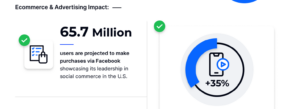
Social Commerce: Why Should It Be A Part of Your Growth Strategy?
In today’s digital-first world, social commerce is reshaping the way businesses interact with consumers and drive revenue. As social media platforms evolve into retail spaces, brands are realizing the importance of including social media commerce in their growth strategy. But why exactly does this trend deserve your attention, and how can businesses harness it to boost sales and build lasting customer relationships? This blog explores the ins and outs of the social commerce industry, why it should be a priority, and how platforms like Snapchat commerce and Instagram commerce are changing the game.
What Is Social Commerce?
Social commerce refers to the integration of eCommerce functionalities directly into social media platforms, allowing users to discover, browse, and purchase products without leaving the platform. Unlike traditional online shopping, where customers are directed to external websites, social shopping makes the entire buying experience seamless within apps such as Instagram, Snapchat, and Facebook.
This emerging social commerce industry is transforming how consumers engage with brands, providing an effortless way to make purchases based on recommendations, influencer posts, and social ads.
Why Should Social Commerce Be Part of Your Growth Strategy?
Investing in social commerce isn’t just a passing trend—it’s becoming a critical part of sustainable business growth. Below are key reasons why brands should integrate it into their marketing and growth strategies:
1. Meeting Customers Where They Already Spend Time
Today, billions of people actively engage with social media platforms every day, making it a goldmine for businesses. Social media commerce allows companies to showcase their products in environments where potential customers are already spending time. This seamless blend of content and shopping enables users to make purchases without interruption, increasing the likelihood of conversion.
- Instagram commerce, for example, leverages product tags that allow users to buy directly from posts or Stories, reducing friction in the buying process.
- Snapchat commerce offers shoppable ads that fit seamlessly into users’ feeds, helping brands connect with Gen Z and millennial audiences.
- Facebook Shops With more than 2.9 billion monthly active users, Facebook remains one of the most influential social media platforms for businesses. Facebook Shops allow businesses to showcase products to highly targeted audiences, leveraging Facebook’s robust ad ecosystem to drive traffic and sales. With features like in-app checkout and product catalogs, customers can discover, engage, and purchase products without ever leaving the app.

2. Boosting Engagement with Authentic Content and Social Proof
One of the primary drivers behind social shopping is the influence of user-generated content, reviews, and social proof. When people see others—especially friends, influencers, or celebrities—using or recommending a product, it boosts trust and drives purchasing decisions.
For instance, product reviews on platforms like Instagram or TikTok foster trust and influence followers to buy. This “social proof” adds credibility that traditional ads often lack. Including social commerce in your strategy helps foster authentic engagement that builds brand trust. Here is an amazing read for you to learn more about other platforms and their performance in terms of social commerce.
3. Reducing Barriers to Purchase with Seamless Shopping Experiences
In traditional eCommerce, customers often abandon purchases due to complicated checkout processes or slow-loading websites. With social media commerce, those barriers are minimized.
Platforms like Instagram commerce and Snapchat commerce provide frictionless shopping by enabling users to complete purchases directly through in-app tools. By simplifying the buying process, businesses can improve conversion rates and offer a better overall experience.
How Social Media Platforms are Integrating eCommerce Features
Social platforms are no longer just communication tools; they are evolving into fully integrated marketplaces. With the rise of social media commerce, platforms are leveraging advanced technologies to enable smoother customer journeys—from product discovery to purchase and post-sale engagement.
1. Native Shopping Features
- Instagram commerce has integrated product tags and in-app checkout options, allowing users to buy products directly from posts, Stories, and Reels without leaving the platform.
- Snapchat commerce offers immersive shopping experiences with augmented reality (AR) try-ons, giving users the ability to interact with products virtually before buying.
2. Artificial Intelligence and Machine Learning
Platforms use AI-driven algorithms to personalize shopping experiences. AI analyzes user behavior to recommend relevant products, helping businesses drive more conversions through targeted marketing. Personalized ads and product suggestions, common in Instagram commerce, create a unique shopping journey tailored to individual users. Incorporating AI into your web development workflow has never been easier and yielded more value.
3. Payment Gateway Integration
Social media platforms are making payments faster and easier by integrating popular gateways and digital wallets. For example, Facebook Shops and Instagram commerce support PayPal, Stripe, and direct credit card payments, allowing businesses to offer multiple payment options that suit customer preferences.

4. API Integrations with eCommerce Platforms
Many social platforms offer APIs that integrate with popular eCommerce systems like Shopify, WooCommerce, and Magento. These integrations ensure that businesses can sync their product catalogs, track inventory in real time, and manage orders from a unified platform. For instance, Instagram commerce allows Shopify stores to directly connect product catalogs to their Instagram profiles, making social shopping more efficient.
The Role of Technology in Social Commerce’s Growth
Technology is the backbone of the social commerce industry. Let’s explore the key innovations that are enabling social platforms to become shopping hubs:
1. Augmented Reality (AR) and Virtual Try-Ons
AR is a game-changer for social shopping. Platforms like Snapchat commerce offer AR filters that allow users to try on clothes, sunglasses, or makeup virtually. These interactive features increase buyer confidence and reduce returns, making AR a valuable tool for brands.
2. Chatbots and Conversational Commerce
AI-powered chatbots provide instant customer support and guide users through the buying process. Some brands use chatbots within social media commerce to answer FAQs, recommend products, and complete transactions—making the shopping experience more efficient and user-friendly.
3. Social Proof and Community-Driven Sales
Platforms are using social proof elements like reviews, likes, and shares to influence purchasing decisions. Instagram commerce takes advantage of influencer marketing and user-generated content (UGC) by enabling influencers to tag products directly in their posts. This community-driven approach builds trust and encourages more users to participate in social shopping.
Why Invest in Social Commerce Now?
1. Rapid Growth of the Social Commerce Industry
The social commerce industry is expanding rapidly, with platforms continuously adding new tools to support businesses. According to industry reports, the global social commerce market is expected to grow significantly over the next few years, driven by increased adoption and consumer demand for convenience. Brands that invest early in social media commerce will be well-positioned to benefit from this upward trend.

2. Cost-Effective Marketing and Sales Channel
Compared to traditional advertising, social commerce offers a more cost-effective way to market products. With targeted ads and organic reach through influencers, brands can drive more conversions without spending heavily on campaigns. Additionally, the ability to analyze metrics such as impressions, clicks, and purchases in real-time helps businesses refine their strategies for better results.
Which Social Platforms Are Leading the Social Commerce Industry?
Different platforms cater to various audiences and offer unique features for social shopping. Below are some of the key players:
- Instagram Commerce: Ideal for visually driven brands, especially in the fashion, beauty, and lifestyle sectors. Instagram’s product tagging and checkout features make it easy to convert followers into buyers.
- Snapchat Commerce: Great for engaging younger audiences with interactive ads and AR-based shopping experiences. This platform excels at connecting brands with Gen Z shoppers.
- TikTok Shopping: Perfect for viral product trends, TikTok combines short-form videos with shoppable content to create a unique shopping experience for users
- Facebook Shops: Offers small businesses the ability to set up customized online stores and manage sales across Facebook and Instagram. It supports multiple payment methods and integrates seamlessly with eCommerce platforms.

How Social Commerce Enhances Customer Experience
- Personalized Recommendations: Social platforms use data-driven algorithms to suggest products based on user behavior, improving relevance and driving sales.
- Faster Customer Service: Brands can respond to inquiries and resolve issues directly within social media channels, ensuring quick, efficient customer support.
- Loyalty Programs and Discounts: Businesses can leverage social media commerce to offer exclusive promotions to followers, fostering brand loyalty and encouraging repeat purchases.
Conclusion
Social commerce is no longer just an optional part of a brand’s strategy—it’s becoming essential for businesses aiming to grow in today’s competitive environment. By offering seamless social shopping experiences and engaging with customers where they already spend time, companies can unlock new growth opportunities. Platforms like Instagram commerce and Snapchat commerce are paving the way for innovative shopping experiences that blend content, community, and convenience.
The rapid growth of the social commerce industry means that businesses need to act quickly to capitalize on these trends. With reduced barriers to purchase, authentic engagement, and personalized shopping experiences, social media commerce offers an unparalleled opportunity to connect with consumers and drive sales. Integrating social commerce into your growth strategy today can set the foundation for long-term success in the digital marketplace.



